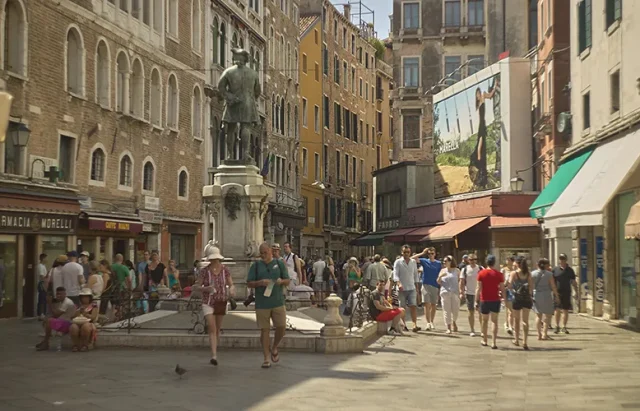
The Grand Tour has travelled far from its origins in the mid-18th century, when youthful Europeans from wealthy families set out on pilgrimages across the continent, however a modern day contemporary Grand Tour is a wonderful opportunity to experience Europe’s stunning range of cultures, histories, and landscapes in a budget-friendly but life-enhancing way. To make the authentic European experience a highlight of 2025 involves grounding it in a balance of current travel technology and being as faithful as possible to the pioneering spirit that defined the classical Grand Tour.
Setting the Stage for Adventure
The key to a successful European Grand Tour is thoughtful planning that blends structure and improvisation. Begin by charting your itinerary, devoting four to eight weeks to sampling the continent in your own time, this provides more than ample time to soak up the quirks of different cultures without falling prey to travel burnout. Organise research visas in advance if you are coming from outside the European Union.
Although free travel within most of Europe is permitted under the Schengen Agreement, check that your passport is not due to expire at least six months after you plan to return home. For longer stays, factor in the impact of the 90-day tourist limit within the Schengen nations. Budgeting means careful regard for Europe’s varied economic conditions. Unbeatable value is provided by Poland, Czech Republic, and Hungary in Eastern Europe, but Scandinavia and Switzerland are places where top dollar is the price tag. Establish a realistic per day budget for dining, transport, and activities, typically €50-100 a day, depending on your travel preferences and style. Plot a rough itinerary that mesh together highlights of capital cities and off-the-map delights.
Consider seasonal differences between locations – Mediterranean countries sparkle in shoulder season, but Christmas markets make Central Europe magical in winter. Learn the local holidays, cultural festivities, and seasonal holidays that will affect your planning. Language preparation doubles the experience. English being widespread in tourist areas, learning a few words for host country languages is a courtesy and will lead to more rewarding interactions. Install translation software and spend some money on a decent phrasebook to consult offline.
Getting Around Europe’s Connected Continent
The European transportation network gives it a very convenient means of travelling around the continent. The Eurail Pass is the venerable old standby of train travel, with flexibility and luxury on 33 nations. The Global Pass offers unlimited travel of 15 days to three months and is ideal for serious travel. Book pass prices in advance, particularly high-speed trains and busy routes during peak season. Low-cost air travel has revolutionised the transport game in Europe, and among the largest airlines that offer cheap fares for major cities are EasyJet, Ryanair, and Wizz Air, and if you opt to ship your luggage rather than pay the additional expense hold bags, it saves money and makes traveling to/from airports a lot easier.
Travel by train is often faster for short trips if total travel time is taken into account. Rental cars give complete freedom to soak up roads and countryside at your own pace. Bring international driving licenses and learn just how different road law is from place to place.
Think of the frustration of crawling through massive cities where public transport will generally be faster and less crazy. Inter-city buses are incredibly inexpensive, with companies like FlixBus running major routes right across Europe. They go farther but are more affordable, and now even buses carry Wi-Fi, charging, and provide decent comfort. City transport varies incredibly from city to city. Purchase city travel cards that allow unlimited use on public transport, which often has additional discounts available on tourist areas. Bike facilities are prioritised in all European cities, so hiring a bicycle is an excellent means of seeing the sights while staying healthy.
From Hostels to Historic Hotels
Accommodation in Europe is available to fit any budget and travel style. Youth hostels have progressed from their austere origins and now offer private rooms, modern facilities, and social atmospheres in which it is easy to meet other travelers. Hostelling International guarantees quality and ease of booking in member hostels.
Boutique hotels in converted historic buildings provide unique character and local flavor, with architectural elements that frequently recall regional tradition. They are intimate and give a feeling of authenticity and support local enterprise and historic building preservation. Renting apartments via websites such as Airbnb enables greater integration within neighborhoods and offers kitchen facilities that are meal-saving.
It is especially worthwhile for longer periods of stay in a single location, with greater value compared to hotels for longer-term stays. Classic bed and breakfasts, which go under many different names throughout Europe, offer intimate and personal interactions with hosts who are unofficial cultural ambassadors. Frequently located in older buildings, they provide a glimpse into local life that is unobtainable at larger hotels. Mix and match accommodation types along the route to experience different aspects of European hospitality. Treat yourself to historic luxury hotels every now and then for special occasions, offset this with budget hostel stays for expensive cities, and use apartment rentals for longer periods where you want to enjoy a country just that little bit more.
Packing for European Adventures
Travelling in Europe entails strategic packing to accommodate both the demands of practicality and the demands of changing climates and activities. Sturdy, high-quality luggage that will withstand rough handling is worth the investment – a hybrid of wheeled suitcase and versatile daypack is sufficient for most travellers. Clothing should be geared toward layering and versatility.
The weather in Europe is unpredictable, and air conditioning in buildings is not the norm, so adaptable clothing is essential. Pack wrinkle-free clothing in neutral shades that mix and match and can transition from day to evening excursions. Electronics to bring along are universal power adapters, portable chargers, and extra charging cables. European outlets vary by country, so full adapters prevent frustration. Pack a light tablet or ipad for extended trip entertainment and offline map access.
Financial preparation involves notification of travel dates to banks to prevent card blocking and being aware of foreign transaction charges. Carry a number of payment methods, along with cash for smaller shops and markets that will not accept cards. Stash emergency funds in various locations. Travel insurance is a trip necessity for cover against medical emergencies, trip cancellation, and stolen luggage.
European medical care is costly for foreigners, so full cover is essential and not a luxury. Take photocopies of important documents and store copies in cloud storage accessible by any device. Sign up with your embassy or consulate for assistance in emergencies. Personal care essentials must be mindful of the availability of products and taste variations between countries. Provide proper quantities of prescribed drugs along with prescription copies and doctor’s letters for controlled drugs.
The 2025 European Grand Tour is an opportunity to see the continent’s incredible variety and create lifelong memories. With methodical planning, smart transportation choices, simple accommodations, and strategic packing techniques, it will be a triumph, as long as you remain flexible and open to the incredible experiences that make European travel so consistently enriching.





